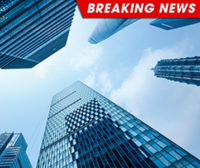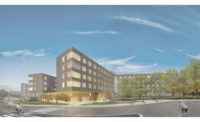Finland's Tallest Mass-Timber Building Rises

Finland’s tallest mass-timber building completed construction in the university city of Joensuu.
A recipient of numerous awards for its mass-timber construction, the building required the development of new, innovative wood construction technology and is widely considered a pioneering project. Only the first floor of the building is constructed with concrete. Apart from this, the framework, including the elevator shaft, is timber construction.
The use of wood as a construction material has significant climate advantages, and Lighthouse Joensuu shows that this is also possible for high-rise buildings. For the entirety of its colorful façade, Steni Colour stone composite panels were specified.
“Steni Colour panels give the façade character. We experimented with glossy and matte surfaces in white and grey shades,” said principal architect Samuli Sallinen with Arkadia Oy Arkkitehtitoimisto. “Although the project is wood construction, the contractor wanted a maintenance-free, waterproof façade, and Steni panels were easy to mount. Being able to put them directly into our 3-D model was a huge advantage.”
The different shades of grey and white give Lighthouse Joensuu more personality, and the impression is enhanced by the spectacular lightwork designed by light artist Kari Kola, which spreads across the building like the branches of a tree, giving it a unique expression in the dark.
The building is more than 160 feet tall and contains 117 student apartments with a view of the lakes and the city of Joensuu, in eastern Finland. The first floor has a sauna facility, laundry room, technical and storage facilities. The apartments vary in size from 280 to 500+ square feet. Although this is a wood-framed project—LVL floors and CLT walls—there are scarcely any wooden surfaces in the building. Due to Finnish fire safety requirements, interior surfaces are primarily covered by plasterboard. Floors one to 13 have nine apartments each, of which two are one-bedroom apartments and the remaining seven are studios.
The project – which won the 2019 Puupalkinto Wood Award and was nominated for 2020’s International Award for Wood Architecture – was also supported by Finland’s Ministry of the Environment. As one of the tallest structures in the city, Lighthouse Joensuu illuminates the skyline by night and acts as a beacon.
As a façade product range, Steni Colour includes 60 standard colors and three gloss levels, and almost any custom color based on NCS or RAL can be specified, enabling a designer limitless creative options and styles.
The panels are installed as ventilated cladding and can be installed at any time of year, irrespective of the temperature and weather. Steni façade panels are diffusion resistant, which means that they can remain submerged in water.
Steni Colour requires minimal maintenance and can be cleaned with most cleaning agents used to wash houses. With the proper cleaning agents, graffiti can be easily removed without ruining the panels. A pressure-washer can also be used on the panels.
Steni products have a small carbon footprint, typically producing 14 to 17 kg CO2/m2. A life-cycle analysis has been conducted for Steni façade panels, which has determined that all have an Environmental Product Declaration (EPD) in accordance with ISO 14025/ISO 21930/EN15804/. The calculation has been performed and verified by a third party, SINTEF. EPD documents have been approved by EPD Norway and Institut Bauen und Umwelt e.V. (IBU).
Looking for a reprint of this article?
From high-res PDFs to custom plaques, order your copy today!





